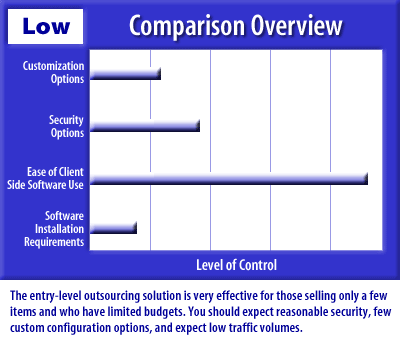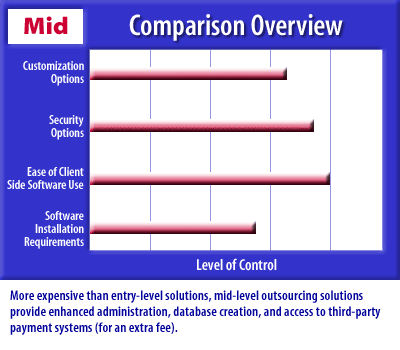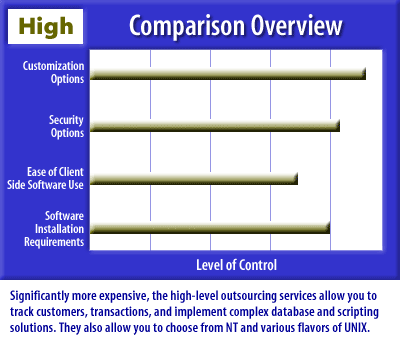| Lesson 9 | Outsourcing |
| Objective | Assess the usefulness of going to outside e-commerce providers. |
Outsourcing Ecommerce Providers and Solutions
Outsourcing to outside e-commerce providers can be a game-changer for businesses looking to streamline operations, cut costs, and scale efficiently. The usefulness depends on your goals—whether it’s saving time, accessing expertise, or staying competitive—but it’s worth breaking down the benefits and examples to see how it plays out in practice.
Usefulness of Outsourcing to Outside E-Commerce Providers
On the other hand, you are trusting someone else with part of your business. If they drop the ball,for example, a logistics provider botches deliveries, it is your reputation on the line. Picking the right partner and keeping tabs on performance are non-negotiable.
Examples of Mid-Level Outsourcing Solutions
Mid-level solutions are practical, targeted fixes that don’t overhaul your whole operation but still pack a punch. These are great for businesses with some traction looking to offload specific burdens.
These options keep costs manageable while plugging gaps in expertise or capacity. They’re not cheap, but they’re not full-on enterprise-level either, maybe hundreds to low thousands per month depending on volume.
Examples of High-Level Outsourcing Solutions
High-level solutions are bigger bets, often for established players or those aiming to scale fast. They involve deeper integration and higher stakes, but the payoff can be transformative.
These solutions often run into five or six figures annually, but they’re built for businesses ready to offload major chunks of work to pros who can execute at scale. The trade-off is less control, so you need airtight contracts and regular check-ins.
Summary Outsourcing to e-commerce providers is useful if you want to save money, tap expertise, or scale without breaking your back or your budget. Mid-level options like customer service or fulfillment are sweet spots for growing businesses, balancing cost and impact. High-level solutions like full-site management or supply chain outsourcing suit bigger players or those eyeing rapid expansion. What is paramount is to match the solution to your size, goals, and bandwidth, then vet providers like your business depends on it, because it does. then vet providers like your business depends on it, because it does.
Usefulness of Outsourcing to Outside E-Commerce Providers
- Cost Efficiency: Hiring in-house teams for every task (think IT, customer service, or logistics) comes with payroll, training, and overhead expenses. Outsourcing shifts these to a variable cost—you pay for what you need, when you need it. For example, a small e-commerce store might save thousands by outsourcing fulfillment instead of renting warehouse space.
- Access to Expertise: External providers often specialize in their niche, bringing skills or tech you’d struggle to build internally. A digital marketing agency, for instance, might have cutting-edge tools and data insights that a solo founder couldn’t afford or master.
- Scalability: E-commerce demand isn’t static—think holiday spikes or viral product launches. Outsourcing lets you flex up or down without the hassle of hiring or firing staff. A fulfillment partner can ramp up shipping capacity overnight, while an in-house team might take weeks to adjust.
- Time Savings: Delegating non-core tasks (like website maintenance or customer support) frees you to focus on what drives growth—product development, branding, or strategy. Time’s the real currency here, especially for lean teams.
- Competitive Edge: With pros handling the nuts and bolts, you can deliver faster shipping, slicker websites, or better customer experiences than competitors stuck doing it all themselves. Speed and quality win in e-commerce.
On the other hand, you are trusting someone else with part of your business. If they drop the ball,for example, a logistics provider botches deliveries, it is your reputation on the line. Picking the right partner and keeping tabs on performance are non-negotiable.
Examples of Mid-Level Outsourcing Solutions
Mid-level solutions are practical, targeted fixes that don’t overhaul your whole operation but still pack a punch. These are great for businesses with some traction looking to offload specific burdens.
- Customer Service Teams: Hiring a third-party call center or virtual assistant crew to handle inquiries, returns, and live chat. A company like Zendesk or a provider from the Philippines might manage this for a fraction of U.S. wages, keeping customers happy 24/7 without you burning the midnight oil.
- Digital Marketing Campaigns: Outsourcing PPC (pay-per-click) ads or social media management to an agency or offshore specialists. They run Google Ads, tweak targeting, and analyze performance, saving you from mastering the ad platforms yourself while driving traffic.
- Order Fulfillment: Partnering with a 3PL (third-party logistics) provider like ShipBob or Fulfillment by Amazon (FBA) to store inventory, pack orders, and ship them out. This cuts the need for your own warehouse and staff, perfect for a mid-sized store with steady sales.
These options keep costs manageable while plugging gaps in expertise or capacity. They’re not cheap, but they’re not full-on enterprise-level either, maybe hundreds to low thousands per month depending on volume.
Examples of High-Level Outsourcing Solutions
High-level solutions are bigger bets, often for established players or those aiming to scale fast. They involve deeper integration and higher stakes, but the payoff can be transformative.
- Full Website Development and Management: Handing your entire e-commerce platform—design, coding, hosting, and updates—to a firm like Shopify Experts or a dev shop in Eastern Europe. They build a custom site, optimize for mobile, and maintain it, letting you focus on product and sales strategy.
- End-to-End Supply Chain Management: Outsourcing the whole logistics chain—from sourcing products to final delivery—to a provider like Flexport or a specialized 3PL. They negotiate with suppliers, manage inventory across multiple warehouses, and handle international shipping, ideal for brands with complex global operations.
- Comprehensive Marketing Overhaul: Contracting a top-tier agency (e.g., Klaviyo for email or a boutique firm) to run your entire marketing ecosystem—SEO, content, email, ads, and analytics. This can cost tens of thousands but delivers a cohesive, data-driven push to dominate your niche.
These solutions often run into five or six figures annually, but they’re built for businesses ready to offload major chunks of work to pros who can execute at scale. The trade-off is less control, so you need airtight contracts and regular check-ins.
Summary Outsourcing to e-commerce providers is useful if you want to save money, tap expertise, or scale without breaking your back or your budget. Mid-level options like customer service or fulfillment are sweet spots for growing businesses, balancing cost and impact. High-level solutions like full-site management or supply chain outsourcing suit bigger players or those eyeing rapid expansion. What is paramount is to match the solution to your size, goals, and bandwidth, then vet providers like your business depends on it, because it does. then vet providers like your business depends on it, because it does.
Legacy Comparison of an IBM Solution with a Microsoft Solution
Today one would be more likely to compare Goole Cloud and AWS solutions when outsourcing the website hosting or planning an infrastructure. The standard price for the "Cadillac edition" of IBM Net.Commerce rounds out to around $20,000, not including hardware or T-1 connectivity (or the monitor). A hardware implementation supporting Microsoft's SiteServer 3.0 E-Commerce Edition is significantly less, though it still reaches over $10,000. For small businesses, or those offering a small range of goods or services, the online instant storefront solution may be the most appropriate e-commerce site creation/administration option.
Outsourced online storefront solutions separate into two subcategories:
- independent and
- portal or community storefronts.
- Cohosting and Colocating:
When outsourcing[1], you can either cohost or colocate. Cohosting means that you are borrowing hard drive space on a machine. Colocating means that you provide your own machine but use the ISP's Internet connection. Yahoo! and other site servers allow the small business owner, for example, to create an e-commerce site that Yahoo! administers for a fixed monthly cost. The cost depends (in the case of Yahoo!) on the number of orders administered monthly. The creation of the site is an interactive process taking little time, effort, or expertise on the owner's part. Colocation is more complex, because it requires you to administer your own server. You borrow only Internet access from an ISP. You can either cohost or colocate. Cohosting means that you are borrowing hard drive space on a machine. Colocating means that you provide your own machine but use the ISP's Internet connection. - When considering the development and management of an outsourcing option,
you should assess.
- Ease of implementation.
- How well the service facilitates interaction between customer and entrepreneur.
- The level of control you can retain over the site.
- Customization options: can you use HTML, ASP, Java or other scripting and dynamic web page features.
- Security options including SSL transactions, password protection, database security and scripting security.
- Ease of client-side software use including simplicity in setting up and creating the website.
- Software installation requirements including hardware considerations.
- Limits imposed by web-hosting capabilities upon the owner's organization.
Security Advice
As you research these options, you should consider the type of servers sites use (NT, UNIX, and so on) and their security measures.
Finally, you should ask whether a site allows you to connect to it under your own DNS name. For example, rather than having customers go to http://www.icat.com/~english-imports, you can pay extra so that the following URL works: http://www.english-imports.com.
The following series of images below shows how capacity changes when moving from low-level to high-level outsourcing solutions.
The following series of images below shows how capacity changes when moving from low-level to high-level outsourcing solutions.
Entry level, Mid-level, and High-level outsourcing Solutions

-
Customization Options
(Small bar representing low level of control) -
Security Options
(Small bar representing low level of control) -
Ease of Client Side Software Use
(Long bar representing high level of control) -
Software Installation Requirements
(Very small bar representing low level of control)


In general, evaluation of storefront solutions involves several basic e-commerce business issues. These include accessibility of the storefront to the consumer, the in-house solution versus outsourcing, and online versus offline storefronts.
Additional issues include integrating the site with back-end systems (invoicing, inventory, and shipping), credit card authorization and encryption solutions, and other security mechanisms. Finally, you must consider whether or not you can customize the way the site interacts with the consumer.
Additional issues include integrating the site with back-end systems (invoicing, inventory, and shipping), credit card authorization and encryption solutions, and other security mechanisms. Finally, you must consider whether or not you can customize the way the site interacts with the consumer.
OutSourcing Ecommerce - Exercise
Click the exercise link below to complete the course project for this module.
OutSourcing Ecommerce - Exercise
OutSourcing Ecommerce - Exercise
[1]Outsourcing: Many entrepreneurs choose to borrow space from an already-existing Internet service provider (ISP).